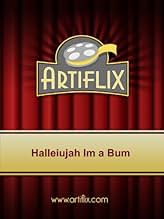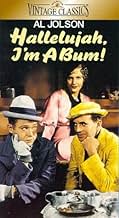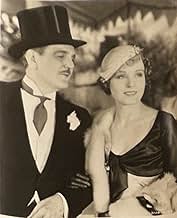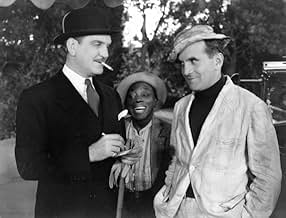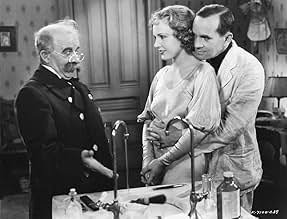PUNTUACIÓN EN IMDb
6,8/10
895
TU PUNTUACIÓN
Añade un argumento en tu idiomaA New York tramp (Jolson) falls in love with the mayor's amnesiac girlfriend after rescuing her from a suicide attemptA New York tramp (Jolson) falls in love with the mayor's amnesiac girlfriend after rescuing her from a suicide attemptA New York tramp (Jolson) falls in love with the mayor's amnesiac girlfriend after rescuing her from a suicide attempt
Ernie Adams
- Man Thrown out of Apartment Building
- (sin acreditar)
Vince Barnett
- Assistant
- (sin acreditar)
Ted Billings
- Bum with Violin
- (sin acreditar)
Heinie Conklin
- Bum
- (sin acreditar)
Gino Corrado
- Mayor's Chef
- (sin acreditar)
John George
- Bum
- (sin acreditar)
Harold Goodwin
- Len
- (sin acreditar)
Reseñas destacadas
This upbeat depression era musical features Broadway sensation Al Jolson as hobo king Bumper. Living in Central Park he and his followers choose a life of leisure to wage slavery debating it in song and rhyme with among others a Red grounds keeper. Even though he's a confidant of the mayor he prefers his laid back lifestyle to patronage work. One night Bumper saves a woman who throws herself off the Bow Bridge. Stricken with amnesia she takes up with Bumper who falls hard enough for her to get a job. When Bumper's "Angel" get's her memory back things change and Bumper returns to his previous vocation.
By 1933 massive unemployment stretched across the land and I can only imagine what the audience reaction of the time might be regarding a musical that extols the joy of joblessness. Jolson's popularity was on the wane having been supplanted by Bing Crosby but he still had enough draw in his voice to make Hallalueh, I'm a Bum a moneymaker and the flimsy story written with sly subversiveness by Ben Hecht does have a light satiric humor to it.
Edgar Conor as sidekick Acorn and silent film clowns Harry Langdon and Chester Conklin add to the film's amiability while Madge Evans as the amnesiac retains a sinewy seductiveness in an evening gown she wears for days on end. Director Lewis Milestone adds his usual camera movements with a striking tableaux here and there but there is also some sloppy back projection and pedestrian editing that gives the finished product a rushed feel. Overall though Hallalueh, I'm a Bum is an oddly interesting take on tough times featuring a legendary talent in fine form.
By 1933 massive unemployment stretched across the land and I can only imagine what the audience reaction of the time might be regarding a musical that extols the joy of joblessness. Jolson's popularity was on the wane having been supplanted by Bing Crosby but he still had enough draw in his voice to make Hallalueh, I'm a Bum a moneymaker and the flimsy story written with sly subversiveness by Ben Hecht does have a light satiric humor to it.
Edgar Conor as sidekick Acorn and silent film clowns Harry Langdon and Chester Conklin add to the film's amiability while Madge Evans as the amnesiac retains a sinewy seductiveness in an evening gown she wears for days on end. Director Lewis Milestone adds his usual camera movements with a striking tableaux here and there but there is also some sloppy back projection and pedestrian editing that gives the finished product a rushed feel. Overall though Hallalueh, I'm a Bum is an oddly interesting take on tough times featuring a legendary talent in fine form.
HALLELUJAH I'M A BUM (United Artists, 1933), directed by Lewis Milestone, with music and lyrics by Richard Rodgers and Lorenz Hart, and starring Al Jolson in his only film for United Artists, is a musical oddity at best that reportedly had failed at the box office when released in theaters, and later went through reissues under different film titles ("Heart of New York") and shorter prints. I first came across this particular movie once on a local TV channel (WTAF, Channel 29, in Philadelpha) in April 1978 titled "Hallelujah, I'm a TRAMP," in which the version I saw was not only choppy but obviously re-dubbed during the song numbers. Fortunately, MGM/UA home video and later DVD copy that's currently available is restored to its full 84 minutes with the picture and sound so clear that it gives the impression that the movie itself was made only a few years ago. So my review will be taken from the basis of that.
Bumper (Al Jolson), a drifting hobo with Acorn (Edgar Connor), his tag-along black companion, return to New York City from Florida. Bumper is close friends with the New York Mayor, John Hastings (Frank Morgan), who pleasures in giving Bumper some money whenever its needed for him. Bumper and his hobo pals sleep on park benches in Central Park while Hastings has problems of his own with his mistress, June Marcher (Madge Evans), whom he believes is being unfaithful with another man named Len. However, after patching things up again while dining together, John gives her a $1,000 bill to put in her purse. However, June misplaces the purse with the money, and when John learns of it, he jumps to his own conclusions in believing she gave Len the money. After a quarrel, John walks out on her. But in reality, the purse got mixed up with the dishes by a waiter and tossed in the trash outside. Bumper and Acorn find the purse and Bumper decides to return it to the rightful owner, the owner being June. By then, June has already left her luxurious apartment disillusioned, with the intentions of not returning. Before leaving, she leaves a note for John. After coming to June's apartment, Hastings finds Bumper waiting there with the purse and explains how he got it. John realizes that June has told the truth and feels foolish. By then, June has headed for Central Park where, later that night, decides to plunge from a bridge to the river below and drown herself. The drifter Bumper sees this and rescues her. Trying to find out who she is, Bumper soon learns the girl has amnesia, and decides to look after her and call her "Angel." He falls desperately in love with "Angel," much to the dismay of his hobo pals, and decides to go to work in a bank to obtain enough money to keep her in an apartment and support her. When he learns who June really is, he is faced with the decision of returning her to Mayor Hastings or to keep silent and keep her all to himself.
The plot as it is somewhat echoes Charlie Chaplin's 1931 silent CITY LIGHTS in which Charlie plays a tramp who befriends a blind girl and goes to work to support her. Here, Jolson's Bumper befriends a girl with amnesia (with both girls being beautiful blondes). Something somewhat new at the time of its release is the rhyming dialogue with songs that accompanied HALLELUJAH I'M A BUM, an experiment that failed to click, although experimented earlier in two Maurice Chevalier 1932 Paramount musicals, ONE HOUR WITH YOU and LOVE ME TONIGHT, the latter scored by Rodgers and Hart. The Jolson version is a new experience for viewers that should be ranked as one of his most atypical film roles. There are no "Mammy" songs and no "blackface" performances either, both which have become traditional and commonplace in a Jolson movie. The Rodgers and Hart rhyming songs/dialogue includes: "Bumper, Bumper," "I Gotta Get Back to New York," "My Pal Bumper," "Hallelujah, I'm a Bum" (two different versions); "Laying the Cornerstone" (a restored segment featuring Frank Morgan and school kids); "Dear June," "Bumper Found a Grand," "What Do You Want With Money?" "Kangaroo Court," "I'd Do It Again" and the best song of all, "You Are Too Beautiful," which is underscored during the film's tender moments. Only the "Kangaroo Court" segment comes off as the only slow point to the story.
HALLELUJAH I'M A BUM (which premiered October 8, 2009, on Turner Classic Movies) also presents Frank Morgan in a rare performance as a serious romantic leading man; Madge Evans as his charming girlfriend who adds beauty to her role; and two former silent screen comedians in speaking parts, Harry Langdon as Egghead; and Chester Conklin as Sunday, adding some humor to the story. The best comedy bit is Louise Carver as Sunday's wife, a no-nonsense landlady who enjoys evicting her tenants for even being minutes late with the rent. Jolson's facial expression after he meets and sees her "charming face" is priceless. The movie is highly recommended, unless a viewer has problems sitting through a movie with mostly rhyming dialogue and no dance numbers. So that there will be no misunderstanding, the storyline does include moments of natural dialogue. (***1/2)
Bumper (Al Jolson), a drifting hobo with Acorn (Edgar Connor), his tag-along black companion, return to New York City from Florida. Bumper is close friends with the New York Mayor, John Hastings (Frank Morgan), who pleasures in giving Bumper some money whenever its needed for him. Bumper and his hobo pals sleep on park benches in Central Park while Hastings has problems of his own with his mistress, June Marcher (Madge Evans), whom he believes is being unfaithful with another man named Len. However, after patching things up again while dining together, John gives her a $1,000 bill to put in her purse. However, June misplaces the purse with the money, and when John learns of it, he jumps to his own conclusions in believing she gave Len the money. After a quarrel, John walks out on her. But in reality, the purse got mixed up with the dishes by a waiter and tossed in the trash outside. Bumper and Acorn find the purse and Bumper decides to return it to the rightful owner, the owner being June. By then, June has already left her luxurious apartment disillusioned, with the intentions of not returning. Before leaving, she leaves a note for John. After coming to June's apartment, Hastings finds Bumper waiting there with the purse and explains how he got it. John realizes that June has told the truth and feels foolish. By then, June has headed for Central Park where, later that night, decides to plunge from a bridge to the river below and drown herself. The drifter Bumper sees this and rescues her. Trying to find out who she is, Bumper soon learns the girl has amnesia, and decides to look after her and call her "Angel." He falls desperately in love with "Angel," much to the dismay of his hobo pals, and decides to go to work in a bank to obtain enough money to keep her in an apartment and support her. When he learns who June really is, he is faced with the decision of returning her to Mayor Hastings or to keep silent and keep her all to himself.
The plot as it is somewhat echoes Charlie Chaplin's 1931 silent CITY LIGHTS in which Charlie plays a tramp who befriends a blind girl and goes to work to support her. Here, Jolson's Bumper befriends a girl with amnesia (with both girls being beautiful blondes). Something somewhat new at the time of its release is the rhyming dialogue with songs that accompanied HALLELUJAH I'M A BUM, an experiment that failed to click, although experimented earlier in two Maurice Chevalier 1932 Paramount musicals, ONE HOUR WITH YOU and LOVE ME TONIGHT, the latter scored by Rodgers and Hart. The Jolson version is a new experience for viewers that should be ranked as one of his most atypical film roles. There are no "Mammy" songs and no "blackface" performances either, both which have become traditional and commonplace in a Jolson movie. The Rodgers and Hart rhyming songs/dialogue includes: "Bumper, Bumper," "I Gotta Get Back to New York," "My Pal Bumper," "Hallelujah, I'm a Bum" (two different versions); "Laying the Cornerstone" (a restored segment featuring Frank Morgan and school kids); "Dear June," "Bumper Found a Grand," "What Do You Want With Money?" "Kangaroo Court," "I'd Do It Again" and the best song of all, "You Are Too Beautiful," which is underscored during the film's tender moments. Only the "Kangaroo Court" segment comes off as the only slow point to the story.
HALLELUJAH I'M A BUM (which premiered October 8, 2009, on Turner Classic Movies) also presents Frank Morgan in a rare performance as a serious romantic leading man; Madge Evans as his charming girlfriend who adds beauty to her role; and two former silent screen comedians in speaking parts, Harry Langdon as Egghead; and Chester Conklin as Sunday, adding some humor to the story. The best comedy bit is Louise Carver as Sunday's wife, a no-nonsense landlady who enjoys evicting her tenants for even being minutes late with the rent. Jolson's facial expression after he meets and sees her "charming face" is priceless. The movie is highly recommended, unless a viewer has problems sitting through a movie with mostly rhyming dialogue and no dance numbers. So that there will be no misunderstanding, the storyline does include moments of natural dialogue. (***1/2)
Slap-happy musical film that tries to use music and images together to meld a new format -- and ends up entertaining and likeable. Many of the songs are "recited" in operatic fashion, as when Jolson, the "Mayor of Central Park" (a famous bum) sings his case in court against a singing tribunal that he's been brought before on chargest of betraying his office by taking a job at a bank. A wonderful tracking shot introduces his job through sucessive levels of importance, beginning with high rollers and ending up with lyricist Lorenz Hart telling a customer he doesn't have a dime to give him. After we see all the varying levels of importance in the bank, we finally come on Jolson and his friend, doing the banking equivalent of peeling potatoes. Wonderful charm of Jolson and Langdon is dulled slightly by Morgan and Evans' stiff leads.
Rodgers music and Hart's lyrics are splendid, making this one of the most original, best written original musicals of all time. It should be noted that in his years later working with Oscar Hammerstein, Rodgers only wrote one original play for film (excluding the televised "Cinderella") -- "State Fair" -- which in my opinion, though charming, has got nothing on "Hallelujah, I'm a Bum!" After the failure of this and several other Rodgers/Hart film projects, the duo returned to Broadway to become almost its only reliably successful writers in the later 30s. They left behind this little Hollywood gem to be rediscovered.
Rodgers music and Hart's lyrics are splendid, making this one of the most original, best written original musicals of all time. It should be noted that in his years later working with Oscar Hammerstein, Rodgers only wrote one original play for film (excluding the televised "Cinderella") -- "State Fair" -- which in my opinion, though charming, has got nothing on "Hallelujah, I'm a Bum!" After the failure of this and several other Rodgers/Hart film projects, the duo returned to Broadway to become almost its only reliably successful writers in the later 30s. They left behind this little Hollywood gem to be rediscovered.
The idea of rhythmic dialogue seems strange today, but was a short-lived fad in the early 30s (best example is the 3 Stooges first Columbia short: "Woman Haters")It works well in Halleleujah, I'm a Bum, since rhyming is only done in parts of the picture.
This was my first introduction to 30s musicals, and is now released on DVD. The "mistress situation" of the Mayor of New York keeping lovely Madge Evans in an apartment in the same building as his is rather interesting as well. Although a "dud" at the boxoffice in 1933, this picture has developed a cult following over the years. Jolson's starring movie career was over by the late 30's due to his ego, but he still has a major reputation as one of the greatest entertainers in history. This picture is a wonderful example of the wild enthusiasm of Hollywood's early talkie musicals with a moral to the story.
This was my first introduction to 30s musicals, and is now released on DVD. The "mistress situation" of the Mayor of New York keeping lovely Madge Evans in an apartment in the same building as his is rather interesting as well. Although a "dud" at the boxoffice in 1933, this picture has developed a cult following over the years. Jolson's starring movie career was over by the late 30's due to his ego, but he still has a major reputation as one of the greatest entertainers in history. This picture is a wonderful example of the wild enthusiasm of Hollywood's early talkie musicals with a moral to the story.
A bum named Bumper and his pals named Acorn and Egghead live a pleasant life in New York with a philosophy that it is better to be a bum than to work for a living. They just happen to be acquaintances with the mayor of New York who is a bit of a playboy.
When the mayor and his lady friend have a quarrel, she despairs and jumps off a bridge to end her life. Bumper happens to see her jump and rescues her from the river. The result of her trauma is that she has temporary amnesia, and she falls in love with Bumper while he is taking care of her.
This is a charming film, with many attributes that make it commendable. "Hallelujah, I'm a Bum" is first and foremost a musical with some drama and comedy added in. Al Jolson's voice and singing are simply wonderful and this movie is good enough to see for the songs alone. The songs are snappy and cheery and if you'd like to be introduced to the famous Al Jolson, this is a good choice. There is also quite a bit of rhythm and rhyme to much of the dialogue in the film which is unique and fascinating. The credits on the film for 'Songs and Musical Dialogue' go to one of the most famous teams of songwriters in the history of film, Richard Rodgers and Lorenz Hart. Their musical brilliance is in evidence in this film.
The cinematography is very good, and it takes us back to 1933 with a 'feel' for what the atmostphere would have been to be bum living in a park in New York, albeit a very happy go lucky bum in a very idealistically happy world. Lewis Milestone, who directed the film is an extremely well known director from the 1930's and 1940's and his skill is evident here.
Al Jolson is a great fit for his role in this movie as the good natured bum, Bumper. His friends Egghead (Harry Langdon) and Acorn (Edgar Connor) are also delightfully cast; these two actors light up the screen anytime they are present. Harry Morgan is terrific as the mayor (He would later be immortalized as the wizard in 1939 in "The Wizard of Oz." Madge Evans is beautiful as the rejected girl friend of the mayor.
This movie is just plain fun to watch and to listen to. I think you might be surprised to find out that this is one of the early 'talking films' which may still have appeal for many film lovers today. There is something timeless about "Hallelujah, I'm a Bum" which makes it well worth watching. I give it a 9/10.
When the mayor and his lady friend have a quarrel, she despairs and jumps off a bridge to end her life. Bumper happens to see her jump and rescues her from the river. The result of her trauma is that she has temporary amnesia, and she falls in love with Bumper while he is taking care of her.
This is a charming film, with many attributes that make it commendable. "Hallelujah, I'm a Bum" is first and foremost a musical with some drama and comedy added in. Al Jolson's voice and singing are simply wonderful and this movie is good enough to see for the songs alone. The songs are snappy and cheery and if you'd like to be introduced to the famous Al Jolson, this is a good choice. There is also quite a bit of rhythm and rhyme to much of the dialogue in the film which is unique and fascinating. The credits on the film for 'Songs and Musical Dialogue' go to one of the most famous teams of songwriters in the history of film, Richard Rodgers and Lorenz Hart. Their musical brilliance is in evidence in this film.
The cinematography is very good, and it takes us back to 1933 with a 'feel' for what the atmostphere would have been to be bum living in a park in New York, albeit a very happy go lucky bum in a very idealistically happy world. Lewis Milestone, who directed the film is an extremely well known director from the 1930's and 1940's and his skill is evident here.
Al Jolson is a great fit for his role in this movie as the good natured bum, Bumper. His friends Egghead (Harry Langdon) and Acorn (Edgar Connor) are also delightfully cast; these two actors light up the screen anytime they are present. Harry Morgan is terrific as the mayor (He would later be immortalized as the wizard in 1939 in "The Wizard of Oz." Madge Evans is beautiful as the rejected girl friend of the mayor.
This movie is just plain fun to watch and to listen to. I think you might be surprised to find out that this is one of the early 'talking films' which may still have appeal for many film lovers today. There is something timeless about "Hallelujah, I'm a Bum" which makes it well worth watching. I give it a 9/10.
¿Sabías que...?
- CuriosidadesHallelujah, I'm a Bum (1933), retitled The Heart of New York, was the first Hollywood feature film to be shown on regularly scheduled USA television. It was broadcast by W2XBS, New York City, on 5 July 1939, two months after their inauguration of regular service which had begun on 30 April 1939 with the opening of the New York World's Fair. It is one of over 200 titles in the list of independent feature films made available for television presentation by Advance Television Pictures announced in Motion Picture Herald 4 April 1942. At this time, television broadcasting was in its infancy, almost totally curtailed by the advent of World War II, and would not continue to develop until 1945-1946.
- PifiasA cameraman's arm is reflected in the partially opened window of the Mayor's limousine when the Mayor meets Bumper at the casino.
- Versiones alternativasA re-dubbed and edited version (for UK release) called "Hallelujah, I'm A Tramp" frequently turns up on television. In this version the soundtrack is momentarily erased whenever the word 'bum' is sung!
- ConexionesFeatured in The All Talking, All Singing, All Dancing Show (1973)
Selecciones populares
Inicia sesión para calificar y añadir a tu lista para recibir recomendaciones personalizadas
Detalles
- Fecha de lanzamiento
- País de origen
- Idioma
- Títulos en diferentes países
- Hallelujah I'm a Bum
- Localizaciones del rodaje
- Pacific Palisades, Los Ángeles, California, Estados Unidos(Central Park scenes)
- Empresas productoras
- Ver más compañías en los créditos en IMDbPro
- Duración1 hora 22 minutos
- Color
- Relación de aspecto
- 1.37 : 1
Contribuir a esta página
Sugerir un cambio o añadir el contenido que falta

Principal laguna de datos
By what name was Soy un vagabundo (1933) officially released in India in English?
Responde
